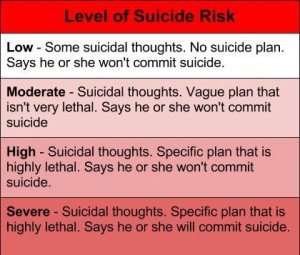[vc_row][vc_column][vc_column_text]By: Ashley Hemrich, M.A. Regional Director of Clinical Partnerships
In September, we stand together to honor National Suicide Prevention Month. Suicide is the 10th leading cause of death worldwide and the number of recorded suicides continues to be on the rise. According to the Center for Disease Control (CDC) National Center for Health Statistics (NCHS), over 47,000 people lost their battle to suicide in 2017, which was also an increase from 2014 (42,000). Putting this into perspective, approximately 123 Americans die from suicide each day, with at least one death by suicide occurring every 12 minutes in the US (CDC). Suicide continues to be an active issue in our communities; however, the topic also continues to be left in the dark. It is with long overview intention that we begin the conversation about suicide to be able to understand what we can do to prevent it.
What is suicide and differences in behaviors?
There are differences in suicidal and parasuicidal behaviors. Suicidal behavior is any action that results in death. Parasuicidal behavior is an action that likely does not result in death. We often group suicidal and parasuicidal behaviors since we believe they are similar, but the difference is the “intent” behind the action. With suicidal behavior, there is typically an intention end one’s life; however, the parasuicidal behavior is more of an impulse to relieve temporary pain without the intention to die. Regardless, both behaviors should be carefully considered to understand someone’s struggles and the action needed to help them.
What are the common misconceptions of suicide?
“People who talk about suicide won’t truly do it.”
Many individuals who are contemplating suicide give clues and/or warning signs. It is vital to never ignore suicidal threats, such as: “Things would be better if I were dead.” “There is no way out.” “I feel so hopeless; I just want to end it right now.”
“Anyone who tries to kill themselves must be foolish and irrational.”
Many people who contemplate suicide are not clinically diagnosed with a mental disorder, but may instead feel hopeless, powerless, grief-stricken, and feel as if there is no way out. They often feel that suicide is their only option after many unsuccessful attempts at trying to heal on their own.
“If a person is determined to kill themselves, then nothing is going to stop them; why bother trying to talk to them.”
This statement is false, as even the most determined person will have mixed feelings about taking their own life. One person can make the difference, which in turn can make the difference for the individual in contemplation. Never doubt the impact you may have on another person.
“People who contemplate suicide are unwilling to seek help.”
The American Foundation for Suicide Prevention states that over 50% of suicide victims sought help at least six months before their deaths. While there are those that may not seek help and believe that they can fight the battle on their own, that does not necessarily mean that they are “unwilling” to seek help. It may be due to limited resources, strained relationships, and not knowing where to turn for support.
“Talking about suicide gives someone the idea to follow through with suicide.”
Discussing suicide with someone in contemplation is one of the most helpful things you can do. The topic of suicide may be uncomfortable and talking about our mental health continues to be a rarely discussed topic of conversation. However, think about how a person may feel to know that you care enough to talk to them about suicide. You can tell them you understand they are struggling, and you are there to support them. Yes, they may completely disregard you and say they are “absolutely fine” at that moment, but your concern may make the difference when they feel as though suicide is their only option.
According to the American Association of Suicidology, below are common warning signs:
- Talking about Killing or Harming Oneself
- “I wish I had never been born…”
- “Nobody would care if I died; I’d be better off dead…”
- “If I ever see you again…”
- Talking or Writing About Death and Dying
- We live in a society where social media is an active part of our connections with others. Many times, those in suffering will post such narratives, poems, and even photos as cries for help. Please do not ignore or disregard them.
- Seeking out Lethal Means
- Immediate access to weapons and/or actively purchasing lethal means for the sole intent to end one’s life (e.g., buying a gun, hoarding medication) access to weapons and/or actively purchasing lethal means for the sole intent to end one’s life (e.g. buying a gun, hoarding medication)
- Feelings of Hopelessness
- **Strong predictor of suicide contemplation
- The belief that things will never get better or change for the better
- “I have nothing to look forward to…”
- “I will never feel better…”
- Saying Goodbye
- Unusual or unexpected visits or phone calls to loved ones
- Saying goodbye to people as if they will never see you again
- Perfecting a living will and/or giving away their prized possessions
- Withdrawing from Others
- Increased social isolation
- Feeling like a burden to others—increased guilt, shame, & self-hatred
- Sudden Sense of Calm & Peace
- This sudden sense of calm and peace is typically mistaken for a positive outcome. We often believe that the individual is “feeling better” and no longer contemplating suicide. This may be the strongest indicator in which they have made the decision to end their life and have mapped out when, where, and how they will follow through on their choice.
What is the connection between suicide and eating disorders?
Sometimes eating disorders are accompanied by thoughts of suicide and parasuicidal behaviors. Eating disorders are a serious mental illness and have the highest mortality rate of all psychological disorders with suicide being the most common cause of death among these individuals. Studies show that those with an eating disorder have significant increases in suicide and suicide attempts when compared to individuals without eating disorders. Those suffering from anorexia have the highest rate of suicide, while those suffering from bulimia has the greatest number of suicide attempts, and 50% of those suffering from binge eating disorder have also attempted suicide. Increased feelings of hopelessness and social isolation coupled with co-occurring disorders, such as depression, anxiety, and other mood-related disorders, along with inadequate sustainable nourishment can be a lethal combination resulting in increased suicidal thoughts and actions.
What are the barriers to seeking help?
One of the key barriers to seeking help is a low perceived need by the individual and our society. As a society, we continue to stigmatize mental health, and for this reason, many people continue to struggle with seeking help. The problem; however, is bigger than the individual and needs to be addressed by a professional. Lack of knowledge regarding available means of help is also a barrier. “Where do I go?” “Who do I talk to?” “What do I say?” “What happens next?”
How do you approach the conversation?
#BeThe1To is the National Suicide Prevention Lifeline’s message for National Suicide Prevention Month. As mental health professionals and community members, we are working with one another to change the conversation by promoting suicide prevention by enacting feelings of hope, healing, and freedom.
We ask that you #BeThe1To:
- ASK: The best way to find out if someone is suicidal is to ASK. Giving the individual in contemplation the opportunity to express their feelings can provide relief from hopelessness and provide comfort in knowing that you care enough about them to ASK. Below are some ways in which to approach the question:
- “I have been concerned about you lately…”
- “Recently, I have noticed some differences in you and wondered how you are doing?”
- “I just wanted to check in with you because you haven’t seemed like yourself lately. Is there something going on that you want to talk about.”
If someone is contemplating suicide:
- “When did you begin feeling like this?”
- “Did something happen that made you feel this way?”
- “How can I best support you right now?”
- “Have you thought about seeking help?”
- “You are not alone in this. I am here for you.”
- “I may not understand how you feel, but I care enough about you and want to help.”
What NOT to do:
- Argue with them
- “You have so much to live for, stop it.”
- Act shocked, lecture the individual on the value of life, give advice, OR tell them your views on suicide
- These reactions will only hinder the individual in contemplation from seeking the help that they need during this critical time.
- Promise complete confidentiality
- “You can talk to me; I won’t tell anyone.”
KEEP THEM SAFE: Please note that no matter the level of suicide risk, the timing of your response should be quick and supportive. Those at highest risk of suicide:
- Have a specific suicide PLAN
- “Do you have a plan to commit suicide?”
- Have the MEANS of carrying out the plan
-
- “Do you have what you need to carry out your plan?”
- Have a TIME FRAME of committing suicide
- “Do you have an idea of when you are planning to carry out your plan?”
- Have an INTENTION of following through with the plan
- “Do you intend to die?”
**NEVER LEAVE THE PERSON ALONE and NEVER DISREGARD THEIR INTENTIONS
- HELP THEM CONNECT: The best way you can help someone is by offering a supportive and active listening ear. Provide support and help them seek professional help at that moment. The National Suicide Prevention Lifeline: 1-800-273-TALK provides toll-free, 24/7 immediate professional care for those in suicidal crisis or emotional distress.
To increase accessibility for crisis services to those in need, The National Suicide Hotline Improvement Act, signed into law in August 2018, has reduced the National Suicide Prevention Lifeline from 10 digits to 3. Given the number of calls and the time it takes to gather information and build rapport, the current 9-1-1 system is not conducive to suicide emergencies. Currently, The Federal Communications Commission is working together to develop the infrastructure of the number, likely to be 9-8-8.
- FOLLOW UP: Research has shown that ongoing support and contact is an important part of suicide prevention. This is especially imperative for those who may have just discharged from hospitals or other care services. Just being present and caring for them can make a world of difference.
- LEARN MORE: The best way to prevent suicide is to get involved in prevention efforts and actively learn more about suicide. Let’s face it, every person in every community is impacted by suicide. As a community, let’s work together #BeThe1To provide prevention resources, as well as honor those who may have lost their battle with suicide.
How can you help raise awareness?
Please join Selah House as we stand together to raise awareness of suicide prevention during September:
- September 7, 2019: Out of Darkness Suicide Prevention Walk presented by the American Foundation for Suicide Prevention in Anderson, IN https://afsp.donordrive.com/index.cfm?fuseaction=donorDrive.event&eventID=5976
- September 8-14: National Suicide Prevention Week: Share resources and promote suicide prevention awareness.
- September 10, 2019: World Suicide Prevention Day: Honor and Remember those affected by suicide, raise suicide prevention awareness, and focus efforts on directing those in suffering to seek help.
If you or someone you know is suffering from an eating disorder, Selah House is here to help. We offer comprehensive care for women and teen girls in a home-like setting. Our Christ-centered, clinical excellent approach embodies our unconditional love and acceptance for our clients exactly as they are in their journey to freedom. Call us today at 765.442.3551 or complete our contact form. We would be honored to show you our Selah Difference.
Additional Resources:
FCC Information: https://www.rollcall.com/news/policy/suicide-prevention-hotline-three-digit-phone-number?fbclid=IwAR3G9EDA886k7pcE8KhD3tJqpbykV4xjw9HBjDnfCAdwp04Mu6fI2HUMYr4
Suicide Prevention Lifeline: https://suicidepreventionlifeline.org/promote-national-suicide-prevention-month/[/vc_column_text][/vc_column][/vc_row]




